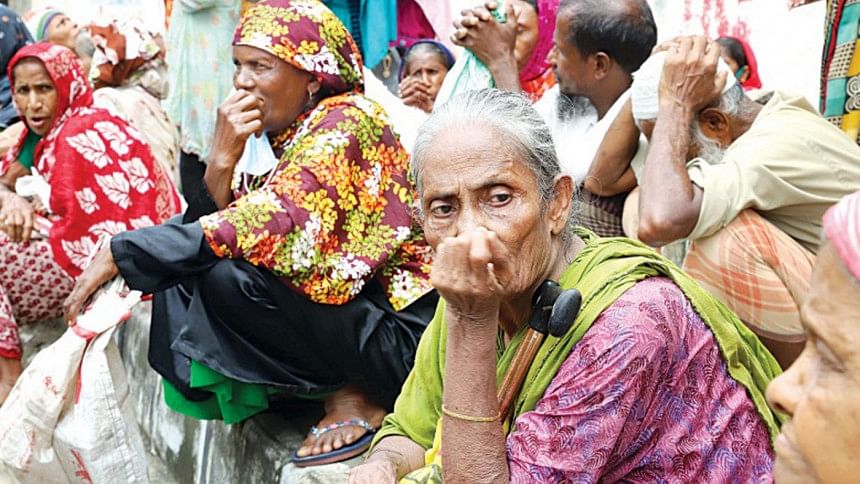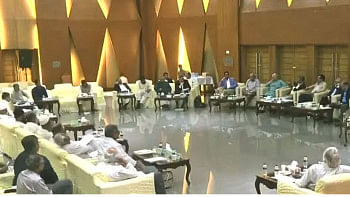Good intentions, poor results: The problem with social safety net programmes

Before the 1990s, it was rare to find social safety nets (also called antipoverty programmes) in most developing countries. At the turn of the millennium, many developing countries, including Bangladesh, started implementing social safety net (SSN) programmes in the form of conditional and unconditional transfers. One reason for the proliferation of SSN is that developing countries have become richer and more politically stable. Another reason is that the success of social programmes in one country is quickly copied in other countries.
Although the SSN's economic rationale is simple—to raise the consumption floor of the poorest—their implementation is complicated. Today in Bangladesh, the combined share of various SSN programmes under "social protection" and "social empowerment" schemes amounts to nearly 15 percent of the fiscal budget or 2.5 percent of GDP—an impressive record for a country with a per capita income less than USD 2,000.
The big question is, how much of the public money is reaching the poorest? To shed light on this question, the Centre for Policy Dialogue (CPD) recently conducted a study in four northern districts of Bangladesh (Gaibandha, Kurigram, Nilphamari and Rangpur) to determine the efficiency of delivery mechanisms of five leading social safety net programmes. These are maternity allowance for poor mothers, primary school stipend programme (PESP), secondary school stipend programme (SESP), employment generation programme for the poorest (EGPP), and old age allowance. The study is timely as the need for a safety net is more profound during the coronavirus pandemic.
The CPD study found that during the Covid-19 pandemic, nearly two-thirds of households that received SSNs are not eligible to receive them! What is so surprising about this finding is that the best available evidence from research also suggests that only about one-third of families in the lowest quintile receive anything from the social safety net. For example, in 2014, the World Bank did a comprehensive study on the coverage of SSN programmes across the developing world and found that only 25 percent of South Asia's poorest receive anything from SSN. For sub-Saharan Africa, the coverage is 20 percent, followed by 28 percent in Middle East and North African countries, and nearly 50 percent in East Asian countries.
It is a no-brainer that corruption is a major cause of the low SSN coverage among the poorest and cracking down on corrupt officials would automatically improve the coverage. Yet, there is no guarantee that fighting corruption would help. Consider an example of an employment generation programme for the poorest (EGPP), which the CPD report found to be a victim of political nepotism. Suppose under the EGPP scheme, the government wants to create 100 jobs for workers in the affected region. The local official is delegated to oversee the EGPP programme.
In reality, less than 100 jobs will be created because the corrupt local official maximises his personal profit when deciding on the number of workers to be employed for the EGPP programme. Since the local official accepts bribes for each job, his marginal cost of corruption increases with each additional employment as the risk of getting caught is greater. By the same principle, his marginal benefit from each new job decreases because of the law of diminishing returns. In the end, the equilibrium employment level is determined by the interaction of the marginal cost and the marginal benefit curves of the corrupt official.
Suppose the equilibrium employment level is 70. Realising that the actual employment level is lower than initially intended, the government decides to crack down on corruption by raising the local official's corruption cost. In the end, the extra surveillance will increase the marginal cost of the corrupt official such that in the new equilibrium, there will be less corruption, but there will also be less employment (say 50, half the original number).
Can anything be done to prevent this? An obvious way to achieve a better outcome is by taking away the local official's power to ration jobs. India tried to overcome this problem through an employment guarantee scheme that ensures sufficient funding to provide at least 100 days of paid employment to any rural family that asks for it. Although the scheme provided an annual average of 40 days of employment with significant variation across states, it offered substantial employment to rural households. The crux of the problem is self-selection, which tends to work relatively better than targeting-based programmes.
The five social safety net programmes for which the CPD study found evidence of corruption, nepotism and political misconduct are all targeting-based schemes. The difficulty in delivering social support through a targeting-based system arises because the welfare metric used to define the poor (occupation, dwelling, education etc.) are not static. Someone who is not poor today can become poor overnight due to illness or unexpected income loss, as the coronavirus pandemic has demonstrated. The poor are fragmented and have weak bargaining power, and in the absence of solidarity from non-poor households, they are a target of exploitation by vested groups.
Therefore, targeting low-income families based on household survey data is often linked to large exclusion and inclusion errors. Even the most well-targeted antipoverty programme in China, often known as Dibao or "subsistence guarantee", has a substantial leakage to households who should not receive them in the first place. In contrast, Brazil's admired Bolsa Familia (family grant) worked reasonably well because it is 85 percent urbanised with a large proportion of the formal sector population. Moreover, like many developing countries, Bangladesh does not have the required administrative capabilities to screen between the haves and have-nots households. As also acknowledged by the CPD, this information constraint is a potential game-changer in delivering social services to those who need them the most.
In comparison, school feeding programmes have far better coverage simply because of such a scheme's universal nature. A low-income family will send their children to public schools if they cannot provide adequate food. This in-built self-selection process makes the distinction between poor and non-poor families futile. The inclusive nature of programmes, such as the school meal programme and universal healthcare, makes the delivery of social services a relative success.
The choice between targeting-based programmes and universalism with self-selection schemes has the same appeal as the perennial aid versus trade question between donor and recipient countries. Poor countries' demand fair trade with rich countries, which shares principles of universalism and favours everyone. Whereas aid is targeted to the poorest corners of society, where politicians have all the incentives to keep the poor in their place on the hope that more aid money will keep flowing.
Eminent Indian sociologist Dipankar Gupta argued that "The best way to fight poverty is to forget them and not plan for them." The argument finds some support in research which suggests that even if all of India's SSN money is equally shared among the entire rural population rather than through public work, it will perhaps do a better job of fighting poverty. A similar argument extends to Bangladesh and other developing countries. A meticulous note-taking on why some safety net programmes work better than others, either at home or abroad, combined with the political will to do so, is the way forward for Bangladesh.
Syed Bashar is a Professor of Economics at East West University. E-mail: [email protected]

 For all latest news, follow The Daily Star's Google News channel.
For all latest news, follow The Daily Star's Google News channel. 



Comments